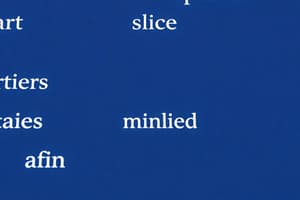Podcast
Questions and Answers
Which type of verb is used to express an action?
Which type of verb is used to express an action?
- Auxiliary verb
- Action verb (correct)
- Reflexive verb
- Linking verb
What is the primary function of a conjunction in a sentence?
What is the primary function of a conjunction in a sentence?
- To modify a noun
- To connect words, phrases, or clauses (correct)
- To show relationships between words
- To replace a noun
Identify the correct example of a complex sentence.
Identify the correct example of a complex sentence.
- She will study all night, yet she may not pass.
- The dog barked loudly at the squirrel.
- Although I was tired, I finished my homework. (correct)
- I like coffee, and she prefers tea.
Which of the following is a type of adverb?
Which of the following is a type of adverb?
What distinguishes a compound-complex sentence from a compound sentence?
What distinguishes a compound-complex sentence from a compound sentence?
In which example is the verb tense in the future perfect continuous?
In which example is the verb tense in the future perfect continuous?
What is the role of a pronoun in a sentence?
What is the role of a pronoun in a sentence?
What type of noun is 'happiness'?
What type of noun is 'happiness'?
Which of the following is true regarding subject-verb agreement?
Which of the following is true regarding subject-verb agreement?
What is the function of a semicolon in a sentence?
What is the function of a semicolon in a sentence?
Which of the following sentences contains a run-on error?
Which of the following sentences contains a run-on error?
What is the primary purpose of using quotation marks in writing?
What is the primary purpose of using quotation marks in writing?
Identify the error in the following sentence: 'Each of the students have completed their assignment.'
Identify the error in the following sentence: 'Each of the students have completed their assignment.'
Which of the following options best describes active voice?
Which of the following options best describes active voice?
Flashcards are hidden until you start studying
Study Notes
English Grammar Study Notes
Parts of Speech
- Noun: Person, place, thing, or idea.
- Types: Common, proper, abstract, collective.
- Pronoun: Replaces a noun (e.g., he, she, it).
- Types: Personal, possessive, reflexive, demonstrative.
- Verb: Action or state of being.
- Types: Action verbs, linking verbs, auxiliary (helping) verbs.
- Adjective: Describes or modifies a noun.
- Types: Descriptive, quantitative, demonstrative, possessive.
- Adverb: Modifies a verb, adjective, or other adverb.
- Answers questions: How, when, where, why, to what extent.
- Preposition: Shows relationship between a noun (or pronoun) and other words.
- Examples: in, on, at, between, under.
- Conjunction: Connects words, phrases, or clauses.
- Types: Coordinating (for, and, nor, but, or, yet, so), subordinating (although, because), correlative (both...and, either...or).
Sentence Structure
- Simple Sentence: Contains a subject and a verb; conveys a complete thought.
- Example: The cat sleeps.
- Compound Sentence: Contains two independent clauses joined by a coordinating conjunction.
- Example: I wanted to go for a walk, but it started to rain.
- Complex Sentence: Contains an independent clause and at least one dependent clause.
- Example: Although it was raining, we went for a walk.
- Compound-Complex Sentence: Contains at least two independent clauses and one or more dependent clauses.
- Example: Although it was raining, we went for a walk, and we enjoyed it.
Tenses
- Present:
- Simple (I walk), Continuous (I am walking), Perfect (I have walked), Perfect Continuous (I have been walking).
- Past:
- Simple (I walked), Continuous (I was walking), Perfect (I had walked), Perfect Continuous (I had been walking).
- Future:
- Simple (I will walk), Continuous (I will be walking), Perfect (I will have walked), Perfect Continuous (I will have been walking).
Agreement
- Subject-Verb Agreement: A singular subject takes a singular verb, and a plural subject takes a plural verb.
- Example: The dog barks (singular), The dogs bark (plural).
- Pronoun-Antecedent Agreement: A pronoun must agree in number and gender with its antecedent.
- Example: Everyone must bring their own lunch (singular antecedent).
Punctuation
- Period (.): Ends a declarative sentence.
- Comma (,): Separates elements in a list, clauses, or adjectives.
- Semicolon (;): Connects closely related independent clauses.
- Colon (:): Introduces a list, quotation, or explanation.
- Apostrophe ('): Shows possession or forms contractions.
- Quotation Marks (" "): Encloses direct speech or quotations.
- Exclamation Mark (!): Indicates strong emotion or emphasis.
Common Errors
- Run-on Sentences: Two or more independent clauses incorrectly joined.
- Fix: Use a conjunction or punctuation.
- Sentence Fragments: Incomplete sentences missing a subject or verb.
- Misplaced Modifiers: Descriptive words placed too far from the word they modify.
- Incorrect Verb Form: Using present tense instead of past, or vice versa.
Style and Usage
- Active Voice: Subject performs the action (e.g., The chef cooked a meal).
- Passive Voice: Subject receives the action (e.g., A meal was cooked by the chef).
- Formal vs. Informal Language: Choose appropriate tone based on audience and context.
- Conciseness: Avoid unnecessary words; be clear and to the point.
Parts of Speech
- Nouns: Represent people, places, things, or ideas; classified into common (general names), proper (specific names), abstract (concepts), and collective (groups).
- Pronouns: Substitute for nouns to avoid repetition; categorized into personal (e.g., he, she), possessive (e.g., mine, yours), reflexive (e.g., myself), and demonstrative (e.g., this, those).
- Verbs: Indicate actions or states of being; types include action verbs (perform actions), linking verbs (connect subject and complement), and auxiliary (helping) verbs (assist main verbs).
- Adjectives: Provide description or modification for nouns; can be descriptive (quality), quantitative (amount), demonstrative (specific), and possessive (ownership).
- Adverbs: Modify verbs, adjectives, or other adverbs; answer essential questions: how, when, where, why, to what extent.
- Prepositions: Establish relationships between nouns/pronouns and other words; common examples include in, on, at, between, under.
- Conjunctions: Connect words, phrases, or clauses; include coordinating (for, and, nor, but, or, yet, so), subordinating (although, because), and correlative (both...and, either...or).
Sentence Structure
- Simple Sentences: Comprise a subject and a verb, expressing a complete thought (e.g., "The cat sleeps").
- Compound Sentences: Feature two independent clauses linked by a coordinating conjunction (e.g., "I wanted to walk, but it started to rain").
- Complex Sentences: Include an independent clause alongside one or more dependent clauses (e.g., "Although it was raining, we went for a walk").
- Compound-Complex Sentences: Contain multiple independent clauses and at least one dependent clause (e.g., "Although it was raining, we went for a walk, and we enjoyed it").
Tenses
- Present Tense:
- Simple (I walk)
- Continuous (I am walking)
- Perfect (I have walked)
- Perfect Continuous (I have been walking)
- Past Tense:
- Simple (I walked)
- Continuous (I was walking)
- Perfect (I had walked)
- Perfect Continuous (I had been walking)
- Future Tense:
- Simple (I will walk)
- Continuous (I will be walking)
- Perfect (I will have walked)
- Perfect Continuous (I will have been walking)
Agreement
- Subject-Verb Agreement: Requires that a singular subject pairs with a singular verb, while a plural subject pairs with a plural verb (e.g., "The dog barks" vs. "The dogs bark").
- Pronoun-Antecedent Agreement: Mandates that a pronoun matches its antecedent in number and gender (e.g., "Everyone must bring their own lunch").
Punctuation
- Period (.): Concludes declarative statements.
- Comma (,): Separates items in lists, clauses, or adjectives for clarity.
- Semicolon (;): Joins closely related independent clauses without a conjunction.
- Colon (:): Introduces lists, quotations, or explanatory elements.
- Apostrophe ('): Denotes possession or forms contractions.
- Quotation Marks (" "): Enclose direct speech or citations.
- Exclamation Mark (!): Conveys strong emotions or emphasizes points.
Common Errors
- Run-on Sentences: Occurs when independent clauses are wrongly joined; can be corrected with conjunctions or appropriate punctuation.
- Sentence Fragments: Consist of incomplete sentences lacking a subject or verb.
- Misplaced Modifiers: Result from descriptive terms positioned far from the words they modify.
- Incorrect Verb Form: Arises from using the wrong tense (e.g., present instead of past).
Style and Usage
- Active Voice: The subject executes the action (e.g., "The chef cooked a meal").
- Passive Voice: The subject receives the action (e.g., "A meal was cooked by the chef").
- Formal vs. Informal Language: Select language style based on the audience and context.
- Conciseness: Emphasizes clear communication by omitting unnecessary words.
Studying That Suits You
Use AI to generate personalized quizzes and flashcards to suit your learning preferences.




